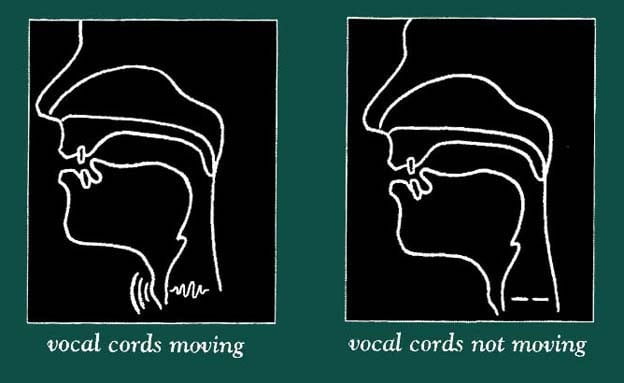In linguistics, sounds produced in human speech are categorised into two main types: voiced and voiceless. These terms refer to the presence or absence of vibration of the vocal cords during articulation of a particular sound. Understanding the distinction between voiced and voiceless sounds is crucial for comprehending the phonetics of languages and how speech sounds are produced.
Voiced Sounds
Voiced sounds are produced when the vocal cords vibrate, creating a buzzing or humming sensation in the throat. This vibration occurs when air passes through the vocal cords, causing them to come together and produce sound. Voiced sounds are typically characterised by a resonant quality and are found in various languages worldwide. Place your hand on your throat to feel this vibration as you pronounce the sound.
Voiced Monophthongs
- /iː/ as in “beet”
- /ɪ/ as in “bit”
- /e/ as in “bet”
- /æ/ as in “bat”
- /ɑ:/ as in “father”
- /ɒ/ as in “cot”
- /ɔ:/ as in “thought”
- /ʊ/ as in “book”
- /uː/ as in “boot”
- /ʌ/ as in “cut”
- /ə/ as in “sofa”
- /ɜ:/ as in “bird”
Voiced Diphthongs
- /aɪ/ as in “like”
- /aʊ/ as in “loud”
- /eɪ/ as in “lake”
- /əʊ/ as in “no”
- /ɔɪ/ as in “boy”
- /ɪə/ as in “beer”
- /eə/ as in “bear”
- /ʊə/ as in “tour”
Voiced Consonants
- /b/ as in “bat”
- /d/ as in “dog”
- /g/ as in “gate”
- /v/ as in “vase”
- /z/ as in “zoo”
- /ʒ/ as in “vision”
- /dʒ/ as in “judge”
- /ð/ as in “this” (voiced ‘th’)
- /m/ as in “man”
- /n/ as in “nice”
- /ŋ/ as in “ring”
- /l/ as in “lake”
- /r/ as in “red”
- /w/ as in “water”
- /j/ as in “yes”
Voiceless Sounds
Voiceless sounds, on the other hand, are produced without vibration of the vocal cords. They are sometimes referred to as “unvoiced” sounds. During the articulation of voiceless sounds, the vocal cords remain apart, allowing air to pass freely through the vocal tract without creating any vibration. As a result, voiceless sounds are typically characterised by a crisp or breathy quality.
Voiceless Consonants
- /p/ as in “pat”
- /t/ as in “top”
- /k/ as in “cat”
- /f/ as in “fan”
- /s/ as in “sat”
- /ʃ/ as in “she”
- /ʧ/ as in “chat”
- /θ/ as in “thing” (voiceless ‘th’)
- /h/ as in “hat”
The distinction between voiced and voiceless sounds is crucial in phonology, studying how sounds function within a particular language. In many languages, pairs of sounds differ only in voicing, a phenomenon known as voicing contrast. For example, in English, the sounds /b/ and /p/ form a voicing contrast; /b/ is voiced, while /p/ is voiceless. Minimal pairs, such as “bat” /bæt/ and “pat” /pæt/, demonstrate how changing the voicing of a single sound can alter the meaning of a word. Here, the initial consonant’s voicing is the only difference between two distinct words.

Understanding the difference between these sounds can help to articulate words more clearly and accurately. Voiceless sounds often correspond to their voiced counterparts in terms of where in the mouth they are articulated, such as /t/ and /d/, both produced by placing the tongue against the alveolar ridge.
Understanding voiced and voiceless sounds is also essential for language learners and speech therapists. Mastery of these sounds enables individuals to pronounce accurately and distinguish between similar sounds in spoken language. These sounds play a critical role in the phonetic structure of languages and are essential for effective communication and language learning.